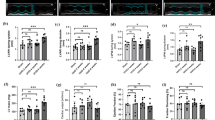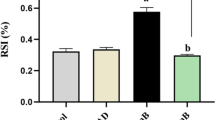Abstract
Arsenic exposure is well documented to cause serious health hazards, such as cardiovascular abnormalities, neurotoxicity and nephrotoxicity. In the present study, we intended to explore the role of bosentan, an endothelial receptor antagonist, against sodium arsenite-induced nephrotoxicity and hepatotoxicity in rats. Sodium arsenite (5 mg/kg, oral) was administered for 4 weeks to induce renal dysfunction in rats. Sodium arsenite intoxicated rats were treated with bosentan (50 and 100 mg/kg, oral) for 4 weeks. Arsenic led renal damage was demonstrated by significant increase in serum creatinine, urea, uric acid, potassium, fractional excretion of sodium, microproteinuria and decreased creatinine clearance in rats. Sodium arsenite resulted in marked oxidative stress in rat kidneys as indicated by profound increase in lipid peroxides, and superoxide anion generation alongwith decrease in reduced glutathione levels. Hydroxyproline assay highlighted arsenic-induced renal fibrosis in rats. Hematoxylin-eosin staining indicated glomerular and tubular changes in rat kidneys. Picrosirius red staining highlighted collagen deposition in renal tissues of arsenic treated rats. Immunohistological results demonstrated the reduction of renal eNOS expression in arsenic treated rats. Notably, treatment with bosentan attenuated arsenic-induced renal damage and resisted arsenic-led reduction in renal eNOS expression. In addition, sodium arsenite–induced alteration in hepatic parameters (serum aspartate aminotransferase, alanine transferase, alkaline phosphatase, bilirubin), oxidative stress and histological changes were abrogated by bosentan treatment in rats. Hence, we conclude that bosentan treatment attenuated sodium arsenite–induced oxidative stress, fibrosis and reduction in renal eNOS expression in rat kidneys. Moreover, bosentan abrogated arsenic led hepatic changes in rats.







Similar content being viewed by others
Data availability
All data generated and analysed during this study are included in the manuscript.
References
Adil M, Kandhare AD, Visnagri A, Bodhankar SL (2015) Naringin ameliorates sodium arsenite-induced renal and hepatic toxicity in rats: decisive role of KIM-1, Caspase-3, TGF-β, and TNF-α. Ren Fail 37:1396–1407
Afyouni NE, Halili H, Moslemi F, Nematbakhsh M, Talebi A, Shirdavani S, Maleki M (2015) Preventive role of endothelin antagonist on kidney ischemia reperfusion injury in male and female rats. Int J Prev Med 6:128
Argos M, Kalra T, Pierce BL, Chen Y, Parvez F, Islam T, Ahmed A, Hasan R, Hasan K, Sarwar G, Levy D (2011) A prospective study of arsenic exposure from drinking water and incidence of skin lesions in Bangladesh. Am J Epidemiol 174:185–194
Caires A, Fernandes GS, Leme AM, Castino B, Pessoa EA, Fernandes SM, Fonseca CD, Vattimo MF, Schor N, Borges FT (2018) Endothelin-1 receptor antagonists protect the kidney against the nephrotoxicity induced by cyclosporine-A in normotensive and hypertensive rats. Braz J Med Biol Res 51:63–73
Chang YK, Choi H, Jeong JY, Na KR, Lee KW, Choi DE (2016) Co-inhibition of angiotensin II receptor and endothelin-1 attenuates renal injury in unilateral ureteral obstructed mice. Kidney Blood Press Res 41:450–459
Cheng YY, Chang YT, Cheng HL, Shen KH, Sung JM, Guo HR (2018) Associations between arsenic in drinking water and occurrence of end-stage renal disease with modifications by comorbidities: a nation wide population-based study in Taiwan. Sci Total Environ 626:581–591
Demirci E, Ferah I, Gundogdu C, Ozkanlar S, Baygutalp NK, Bayir Y, Calik M, Ayaz G (2015) Endothelin receptor inhibition with bosentan delays onset of liver injury in streptozotocin induced diabetic condition. Drug Res (Stuttg) 65:272–280
Dkhil MA, Abdel Moneim AE, Bauomy AA, Khalil M, Al-Shaebi EM, Al-Quraishy S (2020) Chlorogenic acid prevents hepatotoxicity in arsenic-treated mice: role of oxidative stress and apoptosis. Mol Biol Rep 47:1161–1171
Enevoldsen FC, Sahana J, Wehland M, Grimm D, Infanger M, Krüger M (2020) Endothelin receptor antagonists: status quo and future perspectives for targeted therapy. J Clin Med 9:824
Feng HQ, Weymouth ND, Rockey DC (2009) Endothelin antagonism in portal hypertensive mice: implications for endothelin receptor-specific signaling in liver disease. Am J Physiol Gastrointest Liver Physiol 297:G27–G33
Flora SJ (2011) Arsenic-induced oxidative stress and its reversibility. Free Radic Biol Med 51:257–281
Gandhi CR, Nemoto EM, Watkins SC, Subbotin VM (1998) An endothelin receptor antagonist TAK-044 ameliorates carbon tetrachloride-induced acute liver injury and portal hypertension in rats. Liver 18:39–48
Gholamine B, Houshmand G, Hosseinzadeh A, Kalantar M, Mehrzadi S, Goudarzi M (2019) Gallic acid ameliorates sodium arsenite-induced renal and hepatic toxicity in rats. Drug Chem Toxicol 1-12 https://doi.org/10.1080/01480545.2019.1591434
Guha Mazumder D, Dasgupta UB (2011) Chronic arsenic toxicity: studies in West Bengal, India. Kaohsiung J Med Sci 27:360–370
Guidelines for Drinking water Quality (2017) World Health Organisation (WHO). Switzerland 4:1–564
Hossain E, Islam K, Yeasmin F, Karim MR, Rahman M, Agarwal S, Hossain S, Aziz A, Al Mamun A, Sheikh A, Haque A (2012) Elevated levels of plasma Big endothelin-1 and its relation to hypertension and skin lesions in individuals exposed to arsenic. Toxicol Appl Pharmacol 259:187–194
Hsueh YM, Chung CJ, Shiue HS, Chen JB, Chiang SS, Yang MH, Tai CW, Su CT (2009) Urinary arsenic species and CKD in a Taiwanese population: a case-control study. Am J Kidney Dis 54:859–870
Hu Y, Li J, Lou B, Wu R, Wang G, Lu C, Wang H, Pi J, Xu Y (2020) The role of reactive oxygen species in arsenic toxicity. Biomolecules 10:240
Kaur A, Kaur T, Singh B, Pathak D, Singh Buttar H, Pal Singh A (2016) Curcumin alleviates ischemia reperfusion-induced acute kidney injury through NMDA receptor antagonism in rats. Ren Fail 38:1462–1467
Kayankarnna W, Tangvarasittichai O, Tangvarasittichai S (2016) Association between elevated arsenic exposure with chronic kidney disease and oxidative stress in subjects of the contamination area. Int J Toxicol Pharm Res 8:173–178
Kesavan M, Sarath TS, Kannan K, Suresh S, Gupta P, Vijayakaran K, Sankar P, Kurade NP, Mishra SK, Sarkar SN (2014) Atorvastatin restores arsenic-induced vascular dysfunction in rats: modulation of nitric oxide signaling and inflammatory mediators. Toxicol Appl Pharmacol 280:107–116
Kojima H, Sakurai S, Kuriyama S, Yoshiji H, Imazu H, Uemura M, Nakatani Y, Yamao J, Fukui H (2001) Endothelin-1 plays a major role in portal hypertension of biliary cirrhotic rats through endothelin receptor subtype B together with subtype A in vivo. J Hepatol 34:805–811
Lavelle A, Sugrue R, Lawler G, Mulligan N, Kelleher B, Murphy DM, Gaine SP (2009) Sitaxentan-induced hepatic failure in two patients with pulmonary arterial hypertension. Eur Respir J 34:770–771
Miloradović Z, Jerkić M, Jovović Đ, Mihailović-Stanojević N, Milanović JG, Stošić G, Marković-Lipkovski J (2007) Bosentan and losartan ameliorate acute renal failure associated with mild but not strong NO blockade. Nephrol Dial Transplant 22:2476–2484
Mohammadian M, Mianabadi M, Zargari M, Karimpour A, Khalafi M, Amiri FT (2018) Effects of olive oil supplementation on sodium arsenate-induced hepatotoxicity in mice. Int J Prev Med 9:59
Motte S, McEntee K, Naeije R (2006) Endothelin receptor antagonists. Pharmacol Ther 110:386–414
Oshita M, Takei Y, Kawano S, Yoshihara H, Hijioka T, Fukui H, Goto M, Masuda E, Nishimura Y, Fusamoto H (1993) Roles of endothelin-1 and nitric oxide in the mechanism for ethanol-induced vasoconstriction in rat liver. J Clin Invest 91:1337–1342
Rana MN, Tangpong J, Rahman MA (2020) Xanthones protects lead-induced chronic kidney disease (CKD) via activating Nrf-2 and modulating NF-kB, MAPK pathway. Biochem Biophys Rep 21:100718
Ratnaike RN (2003) Acute and chronic arsenic toxicity. Postgrad Med J 79:391–396
Rockey DC, Chung JJ (1996) Endothelin antagonism in experimental hepatic fibrosis. Implications for endothelin in the pathogenesis of wound healing. J Clin Invest 98:1381–1388
Santra A, Chowdhury A, Ghatak S, Biswas A, Dhali GK (2007) Arsenic induces apoptosis in mouse liver is mitochondria dependent and is abrogated by N-acetylcysteine. Toxicol Appl Pharmacol 220:146–155
Shah R (2007) Endothelins in health and disease. Eur J Intern Med 18:272–282
Singh AP, Goel RK, Kaur T (2011a) Mechanisms pertaining to arsenic toxicity. Toxicol Int 18:87–93
Singh AP, Singh N, Pathak D, Bedi PMS (2019) Estradiol attenuates ischaemia reperfusion-induced acute kidney injury through PPAR-γ stimulated eNOS activation in rats. Mol Cell Biochem 453:1–9
Singh R, Singh AP, Singh M, Krishan P (2011b) Impact of obesity on hypertension-induced cardiac remodelling: role of oxidative stress and its modulation by gemfibrozil treatment in rats. Free Radic Biol Med 50:363–370
Skinner R (2011) Nephrotoxicity - what do we know and what don’t we know? J Pediatr Hematol Oncol 33:128–134
Soucy NV, Mayka D, Klei LR, Nemec AA, Bauer JA, Barchowsky A (2005) Neovascularization and angio-genic gene expression following chronic arsenic exposure in mice. Cardiovasc Toxicol 5:29–41
Straub AC, Clark KA, Ross MA, Chandra AG, Li S, Gao X, Pagano PJ, Stolz DB, Barchowsky A (2008) Arsenic-stimulated liver sinusoidal capillarization in mice requires NADPH oxidase-generated superoxide. J Clin Invest 118:3980–3989
Yajima I, Kumasaka MY, Iida M, Oshino R, Tanihata H, Al Hossain A, Ohgami N, Kato M (2017) Arsenic-mediated hyperpigmentation in skin via NF-kappa B/endothelin-1 signaling in an originally developed hairless mouse model. Arch Toxicol 91:3507–3516
Yang F, Yi X, Guo J, Xu S, Xiao Y, Huang X, Duan Y, Luo D, Xiao S, Huang Z, Yuan H (2019) Association of plasma and urine metals levels with kidney function: a population-based cross-sectional study in China. Chemosphere 226:321–328
Yokoyama Y, Baveja R, Sonin N, Nakanishi K, Zhang JX, Clemens MG (2000) Altered endothelin receptor subtype expression in hepatic injury after ischemia/reperfusion. Shock 13:72–78
Zahedi A, Nematbakhsh M, Moeini M, Talebi A (2015) Role of endothelin receptor antagonist; bosentan in cisplatin-induced nephrotoxicity in ovariectomized estradiol treated rats. J Nephropathol 4:134–140
Zhang W, Liu Y, Ge M, Jing J, Chen Y, Jiang H, Yu H, Li N, Zhang Z (2014) Protective effect of resveratrol on arsenic trioxide-induced nephrotoxicity in rats. Nutr Res Pract 8:220–226
Funding
No external funding was available.
Author information
Authors and Affiliations
Contributions
APS conceived the idea, designed and supervised the project. AKS performed pharmacological treatments. AKS, JK did biochemical studies. DP did histological studies. AKS, TK and APS analysed the data. AKS, HNY, TK and APS wrote manuscript. BS and APS critically screened the manuscript. All authors approved the manuscript before submission to the journal.
Corresponding author
Ethics declarations
Conflict of interest
The authors declare no conflict of interests.
Consent to participate
Not Applicable
Consent to publish
Not applicable
Additional information
Responsible Editor: Mohamed M. Abdel-Daim
Publisher’s note
Springer Nature remains neutral with regard to jurisdictional claims in published maps and institutional affiliations.
Rights and permissions
About this article
Cite this article
Sharma, A.K., Kaur, J., Kaur, T. et al. Ameliorative role of bosentan, an endothelin receptor antagonist, against sodium arsenite–induced renal dysfunction in rats. Environ Sci Pollut Res 28, 7180–7190 (2021). https://doi.org/10.1007/s11356-020-11035-0
Received:
Accepted:
Published:
Issue Date:
DOI: https://doi.org/10.1007/s11356-020-11035-0




